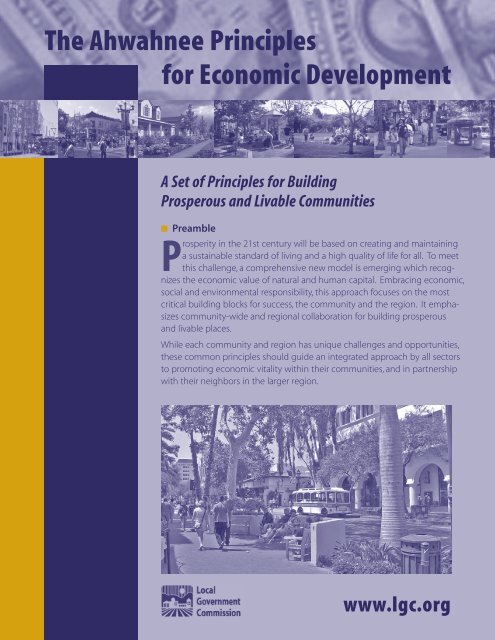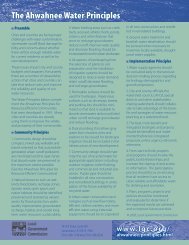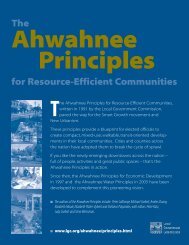Ahwahnee Principles for Economic Development - Local ...
Ahwahnee Principles for Economic Development - Local ...
Ahwahnee Principles for Economic Development - Local ...
You also want an ePaper? Increase the reach of your titles
YUMPU automatically turns print PDFs into web optimized ePapers that Google loves.
The <strong>Ahwahnee</strong> <strong>Principles</strong><strong>for</strong> <strong>Economic</strong> <strong>Development</strong>A Set of <strong>Principles</strong> <strong>for</strong> BuildingProsperous and Livable Communities■ PreambleProsperity in the 21st century will be based on creating and maintaininga sustainable standard of living and a high quality of life <strong>for</strong> all. To meetthis challenge, a comprehensive new model is emerging which recognizesthe economic value of natural and human capital. Embracing economic,social and environmental responsibility, this approach focuses on the mostcritical building blocks <strong>for</strong> success, the community and the region. It emphasizescommunity-wide and regional collaboration <strong>for</strong> building prosperousand livable places.While each community and region has unique challenges and opportunities,these common principles should guide an integrated approach by all sectorsto promoting economic vitality within their communities, and in partnershipwith their neighbors in the larger region.www.lgc.org
The <strong>Ahwahnee</strong> <strong>Principles</strong><strong>for</strong> <strong>Economic</strong> <strong>Development</strong>1 Integrated ApproachGovernment, business, education andthe community should work together tocreate a vibrant local economy, througha long-term investment strategy that:• Encourages local enterprise.• Serves the needs of local residents,workers and businesses.• Promotes stable employment andrevenues by building on localcompetitive advantages.• Protects the natural environment.• Increases social equity.• Is capable of succeeding in theglobal marketplace.2 Vision and InclusionCommunities and regions need a visionand strategy <strong>for</strong> economic developmentaccording to these principles. Visioning,planning and implementation ef<strong>for</strong>tsshould continually involve all sectors,including the voluntary civic sector andthose traditionally left out of the publicplanning process.3 Poverty ReductionBoth local and regional economic developmentef<strong>for</strong>ts should be targeted to reducingpoverty, by promoting jobs that match theskills of existing residents, improving theskills of low-income individuals, addressingthe needs of families moving off welfare,and insuring the availability in allcommunities of quality af<strong>for</strong>dable childcare, transportation and housing.4 <strong>Local</strong> FocusBecause each community’s most valuableassets are the ones they already have, andexisting businesses are already contributingto their home communities, economicdevelopment ef<strong>for</strong>ts should give firstpriority to supporting existing enterprisesas the best source of business expansionand local job growth. Luring businessesaway from neighboring communitiesis a zero-sum game that doesn’t createnew wealth in the regional economy.Community economic developmentshould focus instead on promotinglocal entrepreneurship to build locallybased industries and businesses thatcan succeed among national and internationalcompetitors.5 Industry ClustersCommunities and regions should identifyspecific gaps and niches their economiescan fill, and promote a diversified rangeof specialized industry clusters drawingon local advantages to serve local andinternational markets.6 Wired CommunitiesCommunities should use and invest intechnology that supports the ability oflocal enterprises to succeed, improvescivic life, and provides open access toin<strong>for</strong>mation and resources.7 Long-Term InvestmentPublicly supported economic developmentprograms, investments and subsidiesshould be evaluated on their long-termbenefits and impacts on the wholecommunity, not on short-term job orrevenue increases. Public investmentsand subsidies should be equitable andtargeted, support environmental andsocial goals, and prioritize infrastructureand supportive services that promote thevitality of all local enterprises, instead ofindividual firms.■ For more in<strong>for</strong>mation:LGC Center <strong>for</strong> Livable Communities • 916-448-1198 • www.lgc.org © 1997, <strong>Local</strong> Government Commission, Sacramento, Cali<strong>for</strong>nia.
8 Human InvestmentBecause human resources are so valuable in the in<strong>for</strong>mationage, communities should provide life-long skills and learningopportunities by investing in excellent schools, post-secondaryinstitutions, and opportunities <strong>for</strong> continuous education andtraining available to all.9 Environmental ResponsibilityCommunities should support and pursue economic developmentthat maintains or improves, not harms, the environmental andpublic health.10 Corporate ResponsibilityEnterprises should work as civic partners, contributing to thecommunities and regions where they operate, protecting thenatural environment, and providing workers with good pay,benefits, opportunities <strong>for</strong> upward mobility and a healthfulwork environment.11 Compact <strong>Development</strong>To minimize economic, social and environmental costs andefficiently use resources and infrastructure, new developmentshould take place in existing urban, suburban and rural areasbe<strong>for</strong>e using more agricultural land or open space. <strong>Local</strong> andregional plans and policies should contain these physical andeconomic development planning principles to focus developmentactivities in desired existing areas.12 Livable CommunitiesTo protect the natural environment and increase quality of life,neighborhoods, communities and regions should have compact,multi-dimensional land use patterns that ensure a mix of uses,minimize the impact of cars, and promote walking, bicyclingand transit access to employment, education, recreation,entertainment, shopping and services. <strong>Economic</strong> developmentand transportation investments should rein<strong>for</strong>ce these landuse patterns, and the ability to move people and goods bynon-automobile alternatives wherever possible.13 Center FocusCommunities should have an appropriately scaled and economicallyhealthy center focus. At the community level, a wide rangeof commercial, residential, cultural, civic and recreational usesshould be located in the town center or downtown. At theneighborhood level, neighborhood centers should containlocal businesses that serve the daily needs of nearby residents.At the regional level, regional facilities should be located inurban centers that are accessible by transit throughout themetropolitan area.14 Distinctive CommunitiesHaving a distinctive identity will help communities create aquality of life that is attractive <strong>for</strong> business retention, futureresidents and private investment. Community economicdevelopment ef<strong>for</strong>ts should help to create and preserve eachcommunity’s sense of uniqueness, attractiveness, history andcultural and social diversity, and include public gatheringplaces and a strong local sense of place.15 Regional CollaborationSince industries, transportation, land uses, natural resources andother key elements of a healthy economy are regional in scope,communities and the private sector should cooperate to createregional structures that promote a coherent metropolitan wholethat respects local character and identity.■ www.lgc.org/ahwahnee/econ_principles.html
The <strong>Ahwahnee</strong> <strong>Principles</strong> <strong>for</strong>Resource-Efficient CommunitiesThe <strong>Ahwahnee</strong> <strong>Principles</strong> <strong>for</strong> Resource-Efficient Communities,written in 1991 by the <strong>Local</strong> Government Commission, pavedthe way <strong>for</strong> the Smart Growth movement and New Urbanism.These principles provide a blueprint <strong>for</strong> elected officials to createcompact, mixed-use, walkable, transit-oriented developments intheir local communities.Cities and counties across the nation have adopted them to breakthe cycle of sprawl. If you like the newly emerging downtownsacross the nation – full of people, activities and great public spaces –that’s the <strong>Ahwahnee</strong> <strong>Principles</strong> in action. Since then, the <strong>Ahwahnee</strong><strong>Principles</strong> <strong>for</strong> <strong>Economic</strong> <strong>Development</strong> in 1997, the <strong>Ahwahnee</strong> Water<strong>Principles</strong> in 2005 and the <strong>Ahwahnee</strong> <strong>Principles</strong> <strong>for</strong> Climate Changein 2008 have been developed to complement this pioneering vision.■ www.lgc.org/ahwahnee/principles.htmlThe <strong>Ahwahnee</strong> Water <strong>Principles</strong>Water – how we capture it, treat it, use it, control it, manage itand release it – is vital to the 36 million people who live inCali<strong>for</strong>nia and has a tremendous impact on our quality of life, localbudgets and day-to-day policy-making. And as Cali<strong>for</strong>nia addsanother 12 million residents by 2030, water-resource challengeswill be increasingly serious.Unless we locate new growth in the right places and develop itproperly, the streams, rivers and lakes that receive runoff water willbecome increasingly more polluted and the natural functions ofwatersheds that collect and cleanse our water supplies will diminish.Adopted in 2005, the 14 <strong>Ahwahnee</strong> Water <strong>Principles</strong> – identifiedby water experts as the most effective and viable least-cost optionsto help guide communities concerned about their future watersupplies – address water-wise growth, water conservation, waterfriendlyneighborhood/site-scale planning and design strategies,and implementation strategies to make the physical changesnecessary to ensure water sustainability.The Cali<strong>for</strong>nia State Water Resources Control Board now promotesthe principles and is using them as a way of prioritizing grants andloans to local government. The number of cities and countiesadopting these principles as policy is growing every day.■ www.lgc.org/ahwahnee/h2o_principles.htmlThe <strong>Ahwahnee</strong> <strong>Principles</strong><strong>for</strong> Climate ChangeClimate change is not just another environmental issue. Concentrationsof human-induced greenhouse gases in the atmospherehave already reached unprecedented levels and are causing welldocumentedadverse changes to our planet’s physical and biologicalsystems. We must act decisively to reverse this trend, to lessen thepotentially devastating environmental, economic and social impactsthat could result. At the same time, we must predict and prepare <strong>for</strong>,and adapt to, the unavoidable climatic changes that will likely occurdue to the high concentration of greenhouse gas pollutants that arealready in the atmosphere. <strong>Local</strong> governments are on the front line,both in dealing with the impacts of climate change and in reducinggreenhouse gas emissions. The <strong>Ahwahnee</strong> <strong>Principles</strong> <strong>for</strong> ClimateChange (2008) provide specific guidance <strong>for</strong> local governments tofollow in addressing this urgent and often overwhelming challenge.■ www.lgc.org/ahwahnee/climate_change_principles.html© 1997. <strong>Local</strong> Government Commission. Sacramento, CA. • editing+design: Dave Davis • <strong>Local</strong> Government Commission’s Center <strong>for</strong> Livable Communities • 916 / 448-1198 • www.lgc.org






